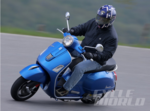Our friends at Cycle World have reviewed the new GTS and they love it. So will you!
2015 VESPA GTS 300 AND GTS 300 SUPER – FIRST RIDE
New front suspension and safety-enhancing electronics keep the GTS at the top of the Vespa heap.
April 29, 2014 By Bruno dePrato
The recently introduced Vespa Primavera has been such a success that there’s a legitimate concern it might overshadow the Vespa GTS 300, especially now that Piaggio has finished honing the livelier Sprint edition. So Vespa has re-focused on the GTS to improve its image, performance, and versatility.
To be clear, this latest Vespa GTS is not the completely new scooter coming in a few years, which is powered by a 350cc Piaggio engine with 33 horsepower. Rather, this latest GTS 300 is an updated version of the current version, but it benefits from a raft of updated electronics that stress rider safety. By incorporating these high-tech electronics into such an iconic scooter, Vespa has come up with a very spicy recipe.
Although it’s unexpected, the new Vespa GTS 300, along with its sportier GTS 300 Super edition, is fitted with an electronics suite that would embarrass many superbikes. The main package includes ABS and ASR traction control, plus an evolution of the multimedia platform used on the Piaggio X10 armchair-style scooter. The ABS, a two-channel system, works with front and rear brake rotors that are both 220mm in diameter. Stopping power is massive, with no risk of wheel lock-up, even under emergency braking on wet bricks or on the cobblestone roads prevalent in so many historic downtowns in Europe, where scooters make so much sense.
Safety is a natural concern in those conditions, and that’s where the Vespa’s ABS shines. The same is true for the ASR traction control, which is controlled by a very powerful ECU that reacts to wheel-spin in only 1/10th of a second, keeping the rider in excellent control of the compact and very agile GTS 300. The multimedia platform, which connects to smartphones, has an App that records data from your trip, including where the Vespa GTS is parked and all diagnostic readouts for the vehicle.
The only major technical update for the new Vespa GTS is its front suspension, which is inspired by the Primavera’s. It features a similar hinged lower shock absorber mount, replacing the previous, rigid mount directly on the trailing arm. The new hinged mount allows the shock absorber to keep the correct working geometry at all times, with no lateral bending and friction to cause a lack of precision and smoothness.
The Vespa GTS 300 comes in two versions: the GTS 300, whose chromed rear luggage rack is inspired by those that came on Vespas in the 1980s. The GTS 300 also has wheels painted silver, a seat trimmed in cream “eco-leather,” and an air intake at the center of the front cowl featuring three chevron-shaped gills. The Vespa GTS 300 Super, the sportier variation, features black-painted wheels, black seat trim with contrasting piping (a nice touch), five almost perfectly flat gills, and no luggage rack. Practicality has been improved with a larger under-seat compartment, and the style of the bike is unchanged, apart from its new high-tech LED lighting front and rear.
I rode the Vespa GTS 300 Super on the hilly roads surrounding Florence, and I must say that the benefits of the new front suspension are even more appreciable than on the lighter Vespa Primavera. In particular, the feedback through the handlebar is largely improved, and you can take my word on this because I am no scooter man. I always ride these kinds of two-wheel vehicles with appropriate caution, but I did grind the center stand of the Super on a few occasions, going around corners with good elan and having lots of fun while doing so.
In Italy, the new Vespa GTS 300 Super currently sells for 5,580 euros, with the standard GTS 300 coming in at 5,480. While we have confirmed that these improved Vespas are coming to the US, the availability date and pricing have not been announced.





